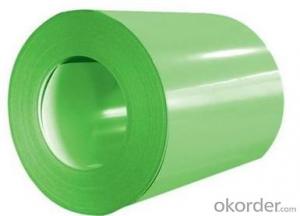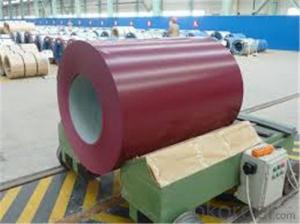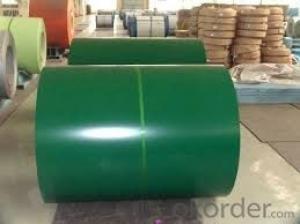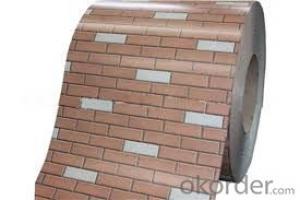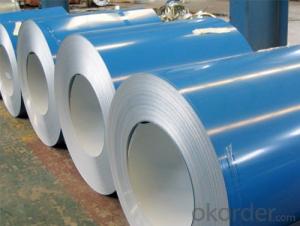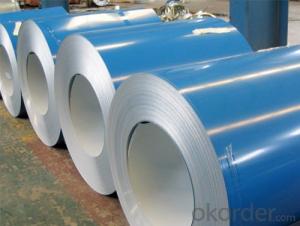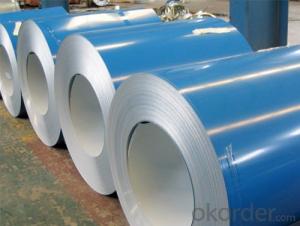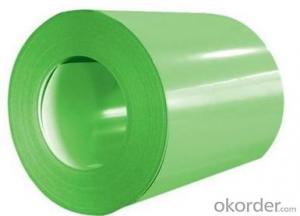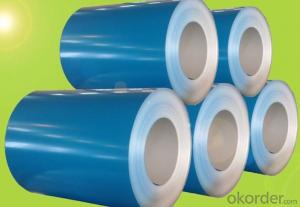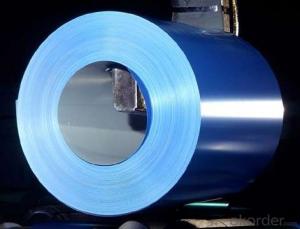Pre-painted Galvanized Sheet Coil with Good Quality and Lowest Price
- Loading Port:
- Shanghai
- Payment Terms:
- TT OR LC
- Min Order Qty:
- 100 m.t.
- Supply Capability:
- 10000 m.t./month
OKorder Service Pledge
OKorder Financial Service
You Might Also Like
1.Structure of Pre-painted Galvanized/Aluzinc Steel Coil Description
With the plate steel is called pre-painted galvanized (aluzinc) steel. Pre-painted galvanized steel is good capable of decoration, molding, corrosion resistance. It generally displays workability, durability and weather resistance.
2.Main Features of the Pre-painted Galvanized/Aluzinc Steel Coil
• Excellent corrosion resistance
• Excellent weather resistance
• Capability of decoration, molding, corrosion resistance
• Workability, durability
• Good formability
• Good visual effect
3.Pre-painted Galvanized/Aluzinc Steel Coil Images
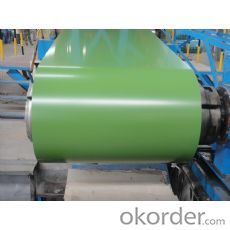
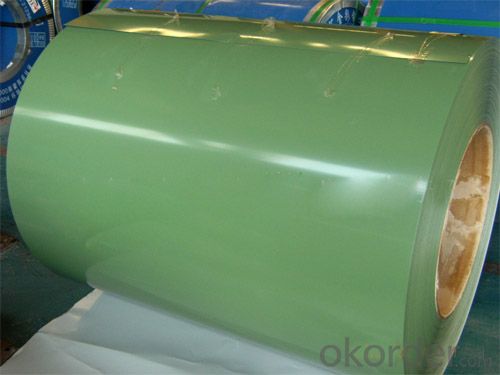
4.Pre-painted Galvanized/Aluzinc Steel Coil Specification
Width : 914mm, 1000mm, 1220mm and 1250mm, thickness 600-1250mm is available
Finish by coil or sheet: Both sheet and coil are available
8Zinc coating: 60-275G/M2, both sides
Paint thickness for top side : 5 micron primer + (10-20) microns modified polyester, any RAL color code.
Quality standar: JIS G3312 CGCC & CGLCC
Hardness of P: Both soft and hard quality are available
Surface finish: with or without protect film
Thickness : 0.14-1.20 mm
Paint thickness for back side: (5-10) microns Epoxy
Weight per coil: 4-6 tons, also can be upon customer's requirements
Max loading weight in one 20ft container : 25 tons generally
5. FAQ of Pre-painted Galvanized/Aluzinc Steel Coil
We have organized several common questions for our clients,may help you sincerely:
. How to guarantee the quality of the products?
We resolutely put an end to unqualified products flowing into the market. At the same time, we will provide necessary follow-up service assurance.
- Q: What are the different types of steel coil handling equipment used during processing?
- There are several types of steel coil handling equipment that are commonly used during processing. Some of these include coil cars, coil upenders, coil grabbers, coil tilters, and coil transfer cars. These equipment are designed to safely and efficiently handle steel coils, allowing for easy movement and positioning during various stages of the processing.
- Q: How much money do you think I could get per lb if I wanted to trade in scrap steel material?
- Scrap steel is usually traded per ton. Average steel prices fluctuate on a daily basis. General prices for scrap steel are around $100 - $200 per ton. For daily scrap steel prices check the source below
- Q: What are the environmental considerations associated with steel coil production?
- The environmental considerations associated with steel coil production include the extraction of raw materials, such as iron ore and coal, which can lead to habitat destruction and air/water pollution. The manufacturing process involves energy-intensive operations and emissions of greenhouse gases, contributing to climate change. Waste generated during production, such as slag and dust, can also have negative impacts on the environment if not properly managed. Additionally, the transportation of steel coils over long distances can result in carbon emissions and increase the overall environmental footprint of the product.
- Q: Can steel coils be used in the food processing industry?
- Indeed, the food processing industry can utilize steel coils. These coils frequently serve as the foundation for a diverse array of food processing equipment, including conveyor belts, food storage tanks, mixing tanks, and processing machinery. Steel, characterized by its durability and hygienic properties, possesses resistance against corrosion, rendering it appropriate for deployment in food processing environments. Furthermore, steel coils facilitate effortless cleaning and sanitization, guaranteeing the safety and cleanliness of the food processing equipment. In conclusion, owing to their robustness, longevity, and adherence to food safety regulations, steel coils enjoy widespread employment within the food processing industry.
- Q: What are the common methods of recoiling steel coils?
- Manufacturers and customers have various options when it comes to recoiling steel coils. One frequently used method is slitting, which employs rotating circular blades to cut a wide steel coil into narrower strips. This results in multiple smaller coils with desired widths. Slitting is commonly employed to create coils of different sizes for diverse applications. Another technique is known as cut-to-length (CTL) recoiling, where the steel coil is cut into specific lengths according to the customer's requirements. This involves passing the coil through a straightening and leveling machine, followed by a flying shear that cuts the steel into the desired lengths. CTL recoiling is particularly useful in industries that demand precise and uniform steel lengths, such as construction or automotive. Furthermore, there is a method called coil-to-coil recoiling. This process involves rewinding the steel coil onto a new coil with the desired dimensions and properties. Coil-to-coil recoiling is typically utilized when the original coil needs resizing, reconditioning, or rerolling for further processing or transportation purposes. Specialized recoiling machines ensure proper tension, alignment, and winding of the steel coil onto the new coil. In conclusion, the recoiling of steel coils can be accomplished through various methods, including slitting, cut-to-length recoiling, and coil-to-coil recoiling. Each method offers its own advantages and is chosen based on factors such as required coil dimensions, precision, efficiency, and the specific needs of the industry or customer.
- Q: How are steel coils inspected for thickness using ultrasonic testing?
- Steel coils can be inspected for thickness using ultrasonic testing, which is a non-destructive testing method. In this process, a handheld ultrasonic thickness gauge is used to measure the thickness of the steel coil. The ultrasonic thickness gauge emits high-frequency sound waves that travel through the steel coil. These sound waves bounce back from the backside of the coil, creating an echo. The time taken for the echo to return to the gauge is measured and used to calculate the thickness of the coil. The gauge consists of a transducer that emits the sound waves and a receiver that detects the echoes. The transducer is placed on the surface of the coil, and a coupling gel or oil is used to ensure a good acoustic contact between the transducer and the steel surface. The transducer emits a short burst of sound waves, which penetrates through the steel coil and reaches the backside. When the sound waves encounter any changes in the thickness of the coil, such as defects or variations, they get reflected back to the transducer. The receiver detects these echoes, and the time between the emission and reception of the sound waves is measured. Using the known speed of sound in steel, the time taken for the sound waves to travel through the coil and back can be converted into a thickness measurement. This provides an accurate assessment of the thickness of the steel coil at various points. Ultrasonic testing is a reliable and efficient method for inspecting the thickness of steel coils. It allows for quick measurements without damaging the material, making it suitable for quality control and ensuring compliance with manufacturing specifications.
- Q: Will hot dip galvanizing affect the properties of the steel
- depends on what your are dipping...i.e what its composition and properties were, was it a spring steel prior?
- Q: How do steel coils contribute to the manufacturing of oil and gas equipment?
- Steel coils are essential in the manufacturing of oil and gas equipment because they provide the necessary raw material for various components. Coils are used to fabricate pipes, valves, tanks, and other critical parts, ensuring their strength, durability, and resistance to high pressure and extreme temperatures. Additionally, steel coils can be easily shaped and formed into different sizes and specifications, enabling manufacturers to meet the specific requirements of oil and gas equipment.
- Q: How are steel coils used in the production of wind turbines?
- Steel coils are used in the production of wind turbines to construct the tower and support structures. The coils are shaped and welded to create the tower sections, providing strength and stability to support the turbine's blades and nacelle. Additionally, the coils are also used to create the structural components, such as the base, for the turbine. Overall, steel coils play a crucial role in the manufacturing process of wind turbines, ensuring their durability and structural integrity.
- Q: Can steel coils be used in the production of furniture?
- Yes, steel coils can be used in the production of furniture. Steel coils can be used to create sturdy frames for furniture such as chairs and sofas. The coils can be shaped and welded together to provide support and durability to the furniture.
Send your message to us
Pre-painted Galvanized Sheet Coil with Good Quality and Lowest Price
- Loading Port:
- Shanghai
- Payment Terms:
- TT OR LC
- Min Order Qty:
- 100 m.t.
- Supply Capability:
- 10000 m.t./month
OKorder Service Pledge
OKorder Financial Service
Similar products
Hot products
Hot Searches
Related keywords
